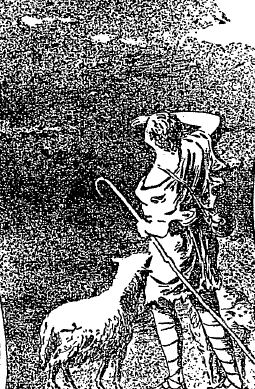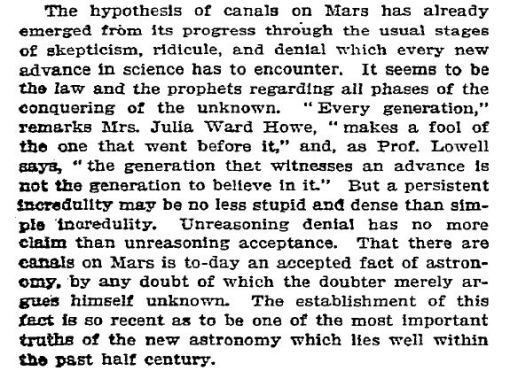May 2010
Monthly Archive
May 24, 2010
Ah, the sweetness of certainty! This spread appeared — appropriately enough! — on page X1 of the New York Times on Decmber 9,1906, when Lowell was — if not “recognised as the greatest authority” on the Red Planet, certainly the only one with his own Observatory from which to study it.

I just love the design of this piece (do check it out in full at the link above, it’s a gloriously giant PDF). The Martian globe seems particularly evocative when seen from below:

and why not throw a shepherd in there, sure!

And as for the content…

Well, The New York Times has been wrong about bigger things, I guess.
May 23, 2010
Posted by plutovian under
the book
Leave a Comment
 That would be William Dufris, who’ll be the voice of Percival’s Planet in its audio book form for Tantor Media. Dufris, as his bio gives us, “has been nominated nine times as a finalist for the APA’s Audie Award and has garnered twenty-one Earphones Awards from AudioFile magazine, which also named him one of the Best Voices at the End of the Century, as well as one of the Best Voices of the Year in 2008 and 2009.”
That would be William Dufris, who’ll be the voice of Percival’s Planet in its audio book form for Tantor Media. Dufris, as his bio gives us, “has been nominated nine times as a finalist for the APA’s Audie Award and has garnered twenty-one Earphones Awards from AudioFile magazine, which also named him one of the Best Voices at the End of the Century, as well as one of the Best Voices of the Year in 2008 and 2009.”
Excellent! Have fun reading all those words! Certainly there are many of them!
Among Dufris’ many credits is the audio book version of Woken Furies, the third installment of the superb Takeshi Kovacs series by Richard K. Morgan. The first in Morgan’s series, Altered Carbon, is so good it must be read to be believed; it’s the book I’m always urging on people as what you gotta pick up next. And those who are true and pure of heart, and who like a little 25th-century-Philip-Marlowe-from-space-reboot, always love it.
May 20, 2010
Posted by plutovian under
exoplanets
Leave a Comment
I’ll admit it, I grew up wanting to visit other worlds. I still do. But what with the severe motion sickness, and the fact that now that I’m officially older than Jack Benny, the odds would seem to be diminishing. On the other hand, we have artists who can put us there — nearly — without the forty months of travel time or the awkwardness of being unfrozen from the cryo-cap (gel, gel, icky gel). This is the work of one Tobias Roetsch, also known as taenaron. He’s 22. He lives in Dresden. He’s awesome. This is via io9.com, Gawker’s excellent sci-fi-culture blog, of which I have no doubt you’re entirely aware.

May 20, 2010
Clyde here at least gets equal billing with Percival Lowell. Notice that in June 1930 astronomers are still puzzling out Pluto’s size. They’re getting closer — rather than being 1200 times the size of Earth, now it’s “judged to be the same size as earth.” (Today we know its mean radius to be 0.18 of Earth.) Estimates of Pluto’s size decreased over the course of the 20th century; in 1976, astronomers determined that Pluto’s surface featured methane ice, which meant that the planet’s albedo was higher than had been theretofore suspected — which, in turn, meant the planet was smaller than it appeared.
The discovery of Pluto’s moon, Charon, in 1978, allowed for very accurate measurements of Pluto’s mass — now determined to be about 0.2% of Earth’s.

Here’s the larger version of that iconic picture of Lowell at his 24″ Clark. Notice the handsome chair. As his descendents say, “Percy brought a lot of Yankee with him to Flagstaff.”
If you visit Lowell Observatory you can see this telescope still in operation — in fact, you can look through it! Check out Lowell’s visiting hours and directions here.
May 18, 2010
Alan Boyle, author of The Case for Pluto, makes an eloquent and moving argument for the importance of thinking of Pluto — and its trans-Neptunian brethren — as full-fledged worlds in their own right. Conceiving of them as worthy of the culturally-weighted term “planet” makes a difference in how we see our own position in the solar system:
 “Never again can Pluto be the ninth planet. Or the littlest planet. Or the most distant planet. But does that make Pluto a non-planet? No way. Even before Pluto was discovered, the solar system was divided into two classes of planets: the rocky worlds like Earth, and the gas giants beyond. Pluto has pointed the way to the solar system’s third great class of planets, no less important than the other two…
“Never again can Pluto be the ninth planet. Or the littlest planet. Or the most distant planet. But does that make Pluto a non-planet? No way. Even before Pluto was discovered, the solar system was divided into two classes of planets: the rocky worlds like Earth, and the gas giants beyond. Pluto has pointed the way to the solar system’s third great class of planets, no less important than the other two…
“Alan Stern, the principal investigator for the New Horizons mission to Pluto, says there could be many thousands of icy worlds out on the solar system’s rim–and hundreds of them could well qualify as dwarf planets. Over the long run, that will almost certainly change the way we look at our own place in the universe. And what’s so bad about that?
“‘The original view, until 10 or 15 years ago, was that we had four Earth-like terrestrial planets, four gas giants, and the misfit Pluto. But the new view is four terrestrial planets, four gas giants, and hundreds of Plutos,'” Stern says. “‘It’s jarring, because Pluto’s no longer the misfit. It’s the Earth-like planets that are the misfits.'”
May 18, 2010
Posted by plutovian under
the book
1 Comment
very solid!

It’s interesting to me how every review so far touches on something different — the Italian crew getting a nod here, for example. I liked them, I liked writing them. They were always hanging around, making remarks, then sort of drifting off when they were no longer really needed.
(Generally family-rated.)
May 17, 2010
May 17, 2010
Trans-Neptunian Objects isn’t a term used much any longer. “Dwarf planets” is the preferred term, if you’re being PC. (“Little planets”, if you’re being really PC.)
 Anyway, these are the biggies. They’re all out beyond Neptune’s orbit. They’re all large enough to be kinda planetlike in some ways — they’re in hydrostatic equilibrium (meaning they get mostly round and stay mostly round). They’re not themselves satellites. But they aren’t large enough to have “cleared their neighboring region of planetesimals,” i.e., to have slurped up all other orbiting bodies unto themselves. Which means, according to the International Astronomical Union’s Resolution 5A of 2006, they aren’t planets.
Anyway, these are the biggies. They’re all out beyond Neptune’s orbit. They’re all large enough to be kinda planetlike in some ways — they’re in hydrostatic equilibrium (meaning they get mostly round and stay mostly round). They’re not themselves satellites. But they aren’t large enough to have “cleared their neighboring region of planetesimals,” i.e., to have slurped up all other orbiting bodies unto themselves. Which means, according to the International Astronomical Union’s Resolution 5A of 2006, they aren’t planets.
And what would Clyde Tombaugh have thought? My impression of Clyde in his later life is of a man at peace with himself. Every picture I’ve seen of him shows him beaming, and surely he was much beloved. Though he defended Pluto’s planetary status when it first was questioned in the 1990s, I believe he also recognized his discovery of Pluto as being something of a happy accident. And today, I can imagine him arguing that we welcome the planetary status of such substantial bodies as Eris, Haumea, Makemake, Orcus, Quaoar, and so on. The universe had made room for him in such an unlikely fashion, after all – I believe he’d have wanted us to return the favor. So on Clyde’s behalf, let the IAU know we want Pluto back!
(Thanks once again to the great Laurel Kornfeld for her ongoing, informed contributions to this discussion – and for filling in some details on the IAU kerfuffle.)
May 14, 2010
So, okay, when you fly in from Planet X and land outside town in 1951, what you need is 1) a bubble helmet 2) pajamas 3) a GIANT voice translator and 4) comfy green gardening gloves.
Oh, also, MAKE SURE YOU LEAVE GRANDMA IN THE SHIP! She tends to wander.

A horrible monstrous creature with a head as big as two men put together... a skin with the shine of a new shilling...eyes no better than a dead codfish!
As IMDB has it:
“…an agent of Planet X, peacefully disposed, has landed to make preparations for further landings of X-people when the planet reaches its closest proximity to Earth. The Man from Planet X, using a mesmeric ray, captures the scientist, his daughter, the assistant and several townspeople.”
This one is even more hilariously subliminal. Check out that “rocket”! Whoopsie!

And guess who that is – yes, it’s Margaret Field, mother of Sally Field! Looks like The Strange Man from Planet X likes her…he really really likes her!

Margaret Field, with dignity restored
May 13, 2010
Not very!
 Pluto is about 1446 miles in diameter – the distance from Flagstaff, Arizona to the Canadian border near Minot, North Dakota.
Pluto is about 1446 miles in diameter – the distance from Flagstaff, Arizona to the Canadian border near Minot, North Dakota.
Pluto’s moon, Charon, is about 750 miles in diameter.
May 13, 2010
I didn’t know until very recently about the kooky theories surrounding Planet X — not in 1930, I mean, but right now, today. While I won’t link to any of the real loonies directly, a quick read of the Wikipedia entry on the Niburu collision should give you a sense of what kinds of lunacy people are capable of committing to. (In sum, the belief involves a NASA conspiracy to cover up the existence of a giant 10th planet on a collision course with Earth.) The most strenuous advocates of this belief appear to be either deeply delusional — I mean, mentally ill — or outright charlatans. Charlatanism is entertaining, but untreated mental illness ain’t.
 Happily, the forces of good are hard at work. The excellent Phil Plait, of Bad Astronomy fame, is on the case against the Planet X conspiracists. Of course, demonstrating logical fallacies, misconceptions, misunderstandings, and the like to a group of conspiracy theorists is sort of like describing soccer to your cats: they might appear to be listening, but their behavior never seems to change.
Happily, the forces of good are hard at work. The excellent Phil Plait, of Bad Astronomy fame, is on the case against the Planet X conspiracists. Of course, demonstrating logical fallacies, misconceptions, misunderstandings, and the like to a group of conspiracy theorists is sort of like describing soccer to your cats: they might appear to be listening, but their behavior never seems to change.
But someone’s got to stand up to the kooks. One more hurrah for the scientists among us! And as Phil Plait says:

May 10, 2010
Posted by plutovian under
blogroll,
the book
1 Comment
Percival’s Planet gets a nice mention on Lab Lit (as very much opposed to Lad Lit) — a list of novels that feature scientists as central characters. Thanks to Dr. Jennifer Rohn, founder of Lab Lit and author of the much-praised novel Experimental Heart, for including the book!

Dr. Jennifer Rohn is a cell biologist at University College London and founder and editor of LabLit.com.
This kind of thing means a lot to me. I like to know that I haven’t misrepresented the scientific endeavor entirely. My father, Peter Byers, is a medical geneticist at the University of Washington; my first novel takes place (in large measure) in a genetics laboratory. In high school I worked occasional afternoons in my father’s lab, responding to reprint requests or photocopying articles from the depths of the library – this was in the dark ages before the Internet – so I was able to witness the workings of his lab from up close, and to observe (in the idle, uncomprehending manner of a teenage nonscientist) the bland make-do surface of daily laboratory life, the not-so-new-any-longer machines, the labels hastily written in black marker on blue tape, the coffeemaker always on and smelling sort of bad — and I loved it all, the long corridors of similar labs down the E wing of the Health Sciences building, the sense that every laboratory interconnected with others around the country and around the world, and the sense that all that effort had been organized by good people in the service of research that might, one day, end a certain variety of human suffering.

Peter Byers, MD
I knew I wanted to write about that sort of work, and though it took me a while to figure out how much it meant to me exactly, the impressive daily enterprise that science is, in full, has always struck me as one of the great human things in the world to be optimistic about. Done well and completely, science is a communal effort, performed in the service of understanding the universe more fully, with an often decades-long time scale. If our species ends up making it on Earth in the long run, it’ll be thanks to those folks who have been undertaking this work for so long. C’mon guys! I don’t want to move to Mars! I just finished planting my tomatoes.
May 10, 2010
Posted by plutovian under
the book
Leave a Comment
Sometimes I think it’d be cool if there were a GPS chip installed in every copy of a book — not just so I could track people down (although that would be interesting and entertaining), but so I could google-map where the dozens of copies were and see where their merry travels had taken them.
I imagine I’d see giant red dots over the book warehouses…a few dots over the houses of friends and family…

…and also, naturally, “charity shops”!

May 5, 2010
Posted by plutovian under
the book
1 Comment
…with another star! You never know what the hell people are going to say about a book once it’s out in the world, so it’s awfully nice to have some pleasing things said right off the bat. It’s especially cool to be compared to Kim Stanley Robinson, a sci-fi dude who is one of my heroes (he wrote Red Mars, which in fact was the favorite book of a character in my previous novel). And Jane Smiley! (I haven’t read Private Life, but I happen to be reading the excellent Ten Days in the Hills right now.) Tickles the mind! Insightful! Witty! Occasionally overwhelming! $27.00!
Whew! I think need to go hose off a little.

May 3, 2010
Stanley Sykes, the fellow on the right, built most of Lowell Observatory’s telescope housings as well as the observatory buildings themselves. He’d begun as a bicycle designer and suffice it to say had his own way of doing things. Many of his creations were successes; others less so. When you visit Lowell Observatory today you can watch the guides shift the giant wooden roof of the Clark Dome. As Jan Millsapps points out in a comment below, the roof is problematically large; the whole roof, maybe 60 feet in diameter, now rolls on Ford truck tires, a solution not arrived at until after Sykes’s time, in the 1950s. (I’d originally posted that it rolled on Model-T tires.) When the great structure is in motion it shudders and creaks and cries — but it moves. It sounds something like a barn being driven down a dirt road.
Here he is with his partner in construction, E.C. Mills, in 1927. As Jan indicates, and as I neglected to point out, Stanley Sykes’s primary partner was in fact his brother Geoffrey — but I don’t have a picture of him.
























